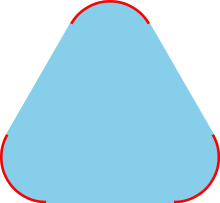
In geometry, the convex hull, convex envelope or convex closure[1] of a shape is the smallest convex set that contains it. The convex hull may be defined either as the intersection of all convex sets containing a given subset of a Euclidean space, or equivalently as the set of all convex combinations of points in the subset. For a bounded subset of the plane, the convex hull may be visualized as the shape enclosed by a rubber band stretched around the subset.
Convex hulls of open sets are open, and convex hulls of compact sets are compact. Every compact convex set is the convex hull of its extreme points. The convex hull operator is an example of a closure operator, and every antimatroid can be represented by applying this closure operator to finite sets of points. The algorithmic problems of finding the convex hull of a finite set of points in the plane or other low-dimensional Euclidean spaces, and its dual problem of intersecting half-spaces, are fundamental problems of computational geometry. They can be solved in time for two or three dimensional point sets, and in time matching the worst-case output complexity given by the upper bound theorem in higher dimensions.
As well as for finite point sets, convex hulls have also been studied for simple polygons, Brownian motion, space curves, and epigraphs of functions. Convex hulls have wide applications in mathematics, statistics, combinatorial optimization, economics, geometric modeling, and ethology. Related structures include the orthogonal convex hull, convex layers, Delaunay triangulation and Voronoi diagram, and convex skull.
- ^ The terminology convex closure refers to the fact that the convex hull defines a closure operator. However, this term is also frequently used to refer to the closed convex hull, with which it should not be confused — see e.g Fan (1959), p.48.
